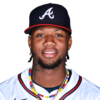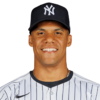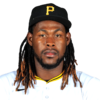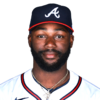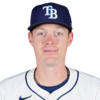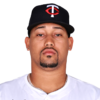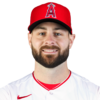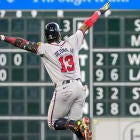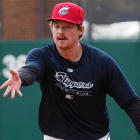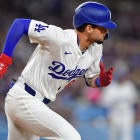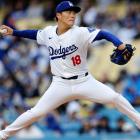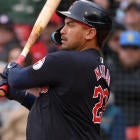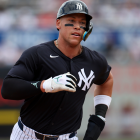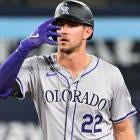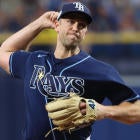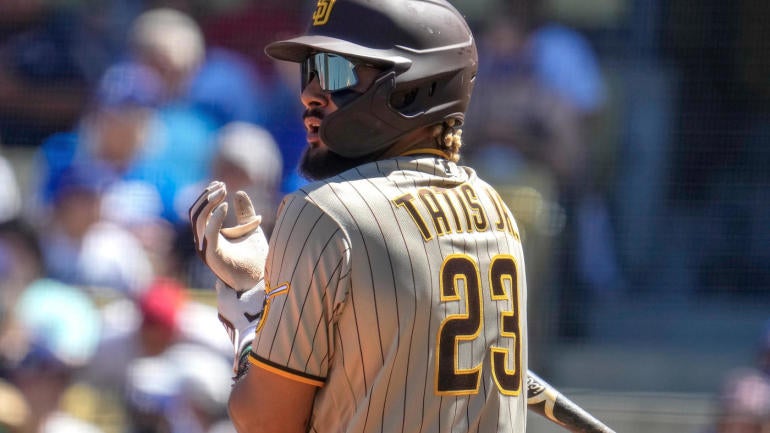
If you're reading this now, chances are a pitcher or catcher has reported somewhere near you. Or, um ... not so near you if you live anywhere other than Arizona or Florida.
The point is that the unofficial start of spring training is here, and it probably has you asking some questions. Or perhaps wondering what questions to ask, if this is your first time tuning in.
That's what I'm here for, a little 20 questions. The most important 20 questions, you might even say, and maybe also a few answers just for good measure.
1) Are stolen base totals about to explode?
If you haven't heard yet, MLB is introducing some rule changes designed to improve the pace of play. Limiting pitchers to two pickoff throws per at-bats figures to be the most significant for Fantasy Baseball purposes, not because the pickoff itself is a meaningful play but because of the big lead runners will be able to take once those attempts are used up.
My suspicion is it'll lead to a democratization of stolen bases the same way we saw a democratization of home runs during the juiced ball era, making them accessible to all. That's basically how it played out in the minors, the number of stolen bases per game jumping from 2.23 to 2.83 and the success rate swelling from 68 to 77 percent. The league itself speculates that stolen base totals could climb to levels not seen since the early 2000s, and I actually think it could be higher than that. The implications for the Fantasy game are considerable, and I'll have much more to say about them in the weeks to come. In the meantime, you can read my initial response to these rule changes when they were announced in September.
2) How much will the shift ban change things?
While the effects of the new pickoff limitations could be completely transformative, the effects of this rule change figure to be more subtle. The league isn't doing away with all shifts, just the most exaggerated ones. From now on, two infielders will need to be on each side of second base, and four will need to have their feet on the dirt. It still leaves a lot of room to maneuver, particularly given how sophisticated infield positioning has become.
Still, teams wouldn't have been implementing those exaggerated shifts if they didn't work, and a select group of hitters, mostly batting from the left side, could see a big boost in batting average now that they've been eliminated. Corey Seager is widely cited as the most likely beneficiary, but a pretty good shorthand is that if a player underperformed his expected batting average (via Statcast) last year, the shift likely played a role, particularly if he bats left-handed.
3) Do we even know what ball we're using?
You laugh, but it's a fair question given the inconsistencies and caginess we've seen in recent years. The deadened ball was reported to be in play in 2021, but we only came to find out after the season that big batches of the old juiced ball were still interspersed throughout the year. Last year seemed like an honest accounting of what a post-juiced ball league would be like, but then reports emerged that a different ball was used in certain situations down the stretch.
We're moving forward in Fantasy Baseball as if last year is the new normal, shying away from our pitching-heavy approaches of the recent past, but would anyone be surprised if the league pulled the rug out from under us again?
4) Is position scarcity a thing again?
Provided last year is the new normal in terms of home run distribution, then oh yes, position scarcity is back. Smallish middle infielders are no longer moonlighting as sluggers, making power again concentrated at lower-defensive-threshold positions like first base.
Shortstop is still pretty deep, though not as high-end as before, and catcher has enjoyed the sort of talent influx that overrides any environmental changes. The positions hurting the most right now are outfield, third base and second base, and I generally like to invest my first three picks in them, in that order. Second base offers enough bounce-back candidates and sleepers that passing it up early is a little easier, but the gap between the studs and duds in the outfield and at third base is stupefying. You can read my full breakdown of each of those positions here, here and here.
5) Can we trust Fernando Tatis will be back to himself?
It's a leap of faith after he burned us all last year. Remember, Tatis was expected back from a fractured wrist midseason, and many drafted and stashed him to be their ace in the hole. But then came multiple setbacks and a PED suspension that ended things once and for all. In the meantime, he elected to have shoulder surgery to address an issue that dated back to his time in the minors. The suspension won't actually end until April 20, so he'll miss the first three weeks no matter the status of his wrist and shoulder. He is allowed to participate in spring training, though, and a strong showing there will go a long way toward relieving our concerns.
The whole situation is reminiscent of Ronald Acuna a year ago. He had a similar timeline coming back from a torn ACL and offered similar best-in-Fantasy-type upside. Acuna never did appear in spring training but got pushed into Round 1 in most drafts anyway. It turned out to be a regrettable move, which is why Tatis' stock may hold in Round 2, but again, a big spring could change everything.
6) Does Aaron Judge have any hope of repeating his historic season?
Like, literally? If he'd need to hit 62 home runs again to answer this one in the affirmative, then probably not. But the gist of the question is whether he should be drafted No. 1 overall since he was far and away the best player in any scoring format last year. More relevant than the actual total was the gap between him and No. 2, Kyle Schwarber, which was 16 home runs. It was the biggest gap for any year in which someone hit 60-plus. Even the year Babe Ruth did it, the gap was smaller.
It was clear from the time Judge hit 52 home runs as a rookie in 2017 that he's outlier in terms of how hard he impacts the ball, and that skill is having more practical effects now that home runs are harder to come by (the abandonment of the juiced ball and all). So no, he may not hit 60 again, but if he hits 55, 50 or even 45, he's probably still the best player in Fantasy.
7) Are we confident Ronald Acuna and Juan Soto will bounce back?
Both debuting in 2018 and placing first and second in NL Rookie of the Year, Acuna's and Soto's careers are inextricably linked. The feats they've achieved before turning 25 are nothing short of historic, and they were the envy of every Dynasty-leaguer prior to last year. But then came last year, when each slipped to career-worst production. Acuna's downturn is easier to explain. He was coming off a torn ACL and still feeling the effects of it, needing occasional off days and being confined to DH from time to time. It didn't slow him on the base paths or reduce his peak exit velocities, but his efforts to manage the injury may have thrown off his swing mechanics slightly.
Soto is a different story. As far as we know, he was completely healthy, yet his batting average declined from .322 the previous two years to .242. His plate discipline was still superlative, enough to make him a stud in points leagues regardless, and his quality of contact remained high. There are no obvious red flags, and between that, his 24 years of age and the fact we all considered him the best hitter in baseball at this time a year ago, he deserves the benefit of the doubt.
They both do, and I wouldn't hesitate to draft either with a mid first-round pick.
8) Can Oneil Cruz get his strikeouts under control?
Remember how I said Aaron Judge is an outlier for how hard he hits the ball? Not so much anymore now that Cruz is in the league. In fact, the 24-year-old set a record for hardest-hit ball in the history of Statcast last year, scalding one 122.4 mph. Contact of such high quality can make up for a lack of quantity, as Judge himself showed back when he used to strike out 30 percent of the time. The problem is that Cruz struck out more like 35 percent of the time as a rookie last year.
He did, however, cut that rate to 29.8 percent in September and, sure enough, went on to hit .288 (34 for 118) with six homers, five steals and an .884 OPS the rest of the way. The hope is he can maintain something closer to that, closer to what Judge used to, in his sophomore season. If he does, we're talking about a possible first-round outcome, 40-plus homers and 20-plus steals. You won't be surprised to learn that Cruz is one of my breakout picks for this year.
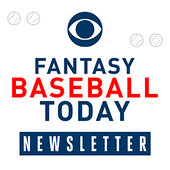
Fantasy Baseball Today Newsletter
Your Cheat Code To Fantasy Baseball
You're destined to gain an edge over your friends with advice from the award-winning FBT crew.
Thanks for signing up!
Keep an eye on your inbox.
Sorry!
There was an error processing your subscription.
9) At what point does the reward outweigh the risk for Bryce Harper?
It's a difficult question to answer because it's not one-size-fits-all. First, to state the obvious, Harper would be a likely first-rounder if not for his recovery from Tommy John surgery, and that sort of infusion into your lineup midseason could be enough to push you across the finish line. Unfortunately, the reported timetables for his recovery are less than favorable, putting his return somewhere around the All-Star break. That's a looong wait -- more than half the season, technically -- and by the time you get him back, your goose may already be cooked.
Since news of his surgery broke, Harper is the 163rd player drafted on average in NFBC leagues, just ahead of (yuck) Harrison Bader. But NFBC mostly hosts 15-team leagues with no IL spots. Generally, these types of gambles make more sense in shallower leagues, where the waiver wire abounds in possible fill-ins. And yeah, having an IL spot makes it all the easier. In typical CBS leagues with 12 teams and IL spots, I look to take Harper just after the big drop-off in the outfield, around Pick 120. If his projected return was in June rather than July, I might take him 30 picks earlier.
10) Can we count on midseason call-ups still?
Stashing top prospects in the hope of a midseason payoff has long been a winning strategy in Fantasy, particularly in leagues of any real size, but it only worked because midseason call-ups were common. While it's true that some of those prospects getting the call may have needed the first couple months to prove they were ready, the reason most teams held off until the summer is because they were incentivized to do so. Waiting until mid-May meant another year of team control. Waiting until late June meant that year would be pre-arbitration.
But the new CBA last year changed the incentives. Draft picks are now awarded to teams whose top prospects go on to place in awards voting over the first few years of their career, but only if they were on the roster for their entire rookie season. So now, rather than midseason, I suspect the biggest influx of talent will come in September. It's a chance to audition a prospect for the following year without using up his rookie eligibility, and indeed, we saw the floodgates open last September.
Perhaps, then, it's not as wise to invest in prospects who don't make the opening day roster.
11) So which prospects are the most likely to make the opening day roster?
You mean beyond those who debuted late last year? Because that would exclude Corbin Carroll and Gunnar Henderson, the first two prospects drafted in every league this year. They're virtual locks for opening day. It would exclude Triston Casas, Ezequiel Tovar, Miguel Vargas or any of the prospects who got their feet wet last September (see link above). You know about them already, and if you don't, you better learn.
If you mean strictly the ones who haven't debuted yet, three names in particular stand out: Orioles pitcher Grayson Rodriguez, Cardinals outfielder Jordan Walker and White Sox outfielder Oscar Colas. All are known to be in the running for a job, and in the case of Rodriguez and Colas, there aren't great alternatives. Walker would be the most exciting of all as a consensus top-five prospect who's currently eligible at third base and would gain eligibility in the outfield, two of the weakest positions, but the Cardinals do have quite the logjam in the outfield. I would say Rodriguez needs to be drafted in all leagues and Walker and Colas in all five-outfielder leagues.
12) Will the humidor crush early-season offense again?
The league as a whole hit .231 with a .676 OPS last April. It hit .236 with a .686 OPS through May 20. MLB had gone too far in correcting its juiced ball problem, it seemed. In particular, players who made their bones through high fly-ball rates rather than premium exit velocities got crushed. Marcus Semien was probably the poster child. He entered June -- the one-third point of the season, mind you -- batting .199 with only one home run and a .540 OPS.
But he went on to hit .268 with 25 homers and an .810 OPS over the next four months, salvaging his season and rewarding the most patient among us. He wasn't the only one either. Offense came surging back once the weather warmed up. Warm weather has always favored offense, sure, but the night-and-day difference for certain players was something we hadn't seen before. The most likely explanation is that every park made use of a humidor last year. For consistency purposes, game balls were stored at the same temperature and humidity level across the league. It was a fine idea in theory, but what matters more than a ball's temperature and humidity is its temperature and humidity relative to the air around it. If the air is colder and dryer, the ball deadens. If the air is warmer and wetter, the ball livens.
Guess what the air was last April and May? Really, really cold -- unseasonably so. If the weather is milder at the start of this year, maybe the splits won't be so extreme. But they will be a factor still, which means you'll need to be patient with guys like Semien.
13) Michael Harris can't really be this good, can he?
Well, he was a top prospect who went on to win NL Rookie of the Year, so in that respect, maybe he can. But he wasn't a tippy-top prospect, the kind you'd expect to be a five-category standout right away. He wasn't Julio Rodriguez, in other words, and yet by per-game production, it's a close call who was actually better last year. Harris isn't being drafted in Round 1 this year like Julio Rodriguez is, so skepticism is already baked in. But he is being drafted in Round 3 -- sometimes late Round 2, even -- which means he can't afford too big of a step back.
What worries me is the kind of outlier he has to be to sustain his production from last season. His 56.2 percent ground-ball rate was second only to Christian Yelich, whose troubles putting the ball in the air are well documented, and among those with even a 50 percent ground-ball rate, Vladimir Guerrero was the only other player with better than a .200 ISO. Is that an oddity Harris could replicate to year after year? What complicates the situation is that we really need him to be that good because outfield really is that bad, so I'm just as likely to take Harris at his going rate even though I have my doubts.
14) Are the Yankees ready to turn the page on their aging infield?
Anthony Rizzo is doing just fine at first base, so I'm mostly talking about Josh Donaldson, DJ LeMahieu and Isiah Kiner-Falefa. Yes, I realize Kiner-Falefa is only 27, but be real -- he's the one who most needs to go. Waiting in the wings are two particularly impressive prospects: Oswald Peraza, who actually got a look late last year, and Anthony Volpe, who most rank lists put in the top 10 overall.
I haven't yet mentioned Gleyber Torres, who appears to have shored up second base with a bounce-back performance last year. Factor him in and the Yankees infield is overloaded even before you account for the prospects, which is all the more reason this transition will take deliberate action on their part. The natural position for both Peraza and Volpe is shortstop, but many scouts think Volpe would fit best at third. Could manager Aaron Boone be convinced to pull the plug on Kiner-Falefa and Donaldson? He seemed reluctant to integrate Peraza last year.
15) What effect will the changes to Comerica Park and Rogers Centre have?
Neither situation is anything like what the Orioles did to Camden Yards last year. Pushing a fence back 30 feet would be extreme if it was some obscure feature that spanned just a small section of wall, but in that case, it was all of left field. And they raised the height of the fence, too. They went from having one of the majors' most homer-friendly parks to having a nightmare for right-handed hitters.
The changes to Comerica Park and Rogers Centre won't be that transformative, and they'll be to the benefit of hitters rather than pitchers. The Tigers are moving in what had been the deepest fence in center field, but only 10 feet. They're also lowering the fences slightly. It's been a stifling park for players like Nick Castellanos in the past and Javier Baez in the present, but the impact of these changes figures to be minimal.
Rogers Centre had been a hitter's park until recently. The Blue Jays began using a humidor a year before most other teams, and the venue has played slightly pitcher-friendly since then. The changes there are more significant, but also somewhat contradictory. The walls will no longer be uniform in height, being raised by various amounts all the way around, but they're also moving in, by as much as 16 feet in right-center. It could go back to playing more like a hitter's park as a result, but I'm not ready to say anyone's value is completely transformed by it.
16) Will the Mariners, Rays and Twins settle on a closer already?
They've been three of the teams most committed to the committee, but there have been signs that maybe they're ready to go with a more traditional closer. They certainly have the personnel for it:
While Sewald would appear to have the firmest hold on the role, claiming 20 saves last year, he also has the stiffest competition in Andres Munoz. The Rays and Twins have Jason Adam and Jorge Lopez, respectively, but it's doubtful either claims the role outright.
The game has trended more toward closer committees in recent years, but a dialing back of that trend would go a long way toward relieving scarcity in the reliever ranks. As things presently stand, less than half of all teams have a surefire ninth-inning option, and the cost of those confirmed to be in the role is rising to untenable levels.
17) What hope do Lucas Giolito and Jose Berrios have for a rebound?
They're 28 years old -- that's what. But seriously, in the context of an improving pitcher environment, it's hard to explain what exactly went wrong for them. Both had been early-round fixtures for over three years and were thought to be among the safer pitcher investments last year. But each pitcher's season went off the rails early and never got back on track.
At first glance, Giolito would seem like the worse bet to rebound since he did see some decline in velocity, but he's been more open about the work he's put in this offseason, noting that his delivery got out of whack as he adjusted to 20 extra points of muscle. He's slimmed down again and feels like he's in a good spot mechanically. If you can get him or Berrios as your sixth or seventh starter, it seems well worth the gamble. The deeper pitcher crop may have us downgrading them more severely than similar cases in the past.
18) How will Kodai Senga's "ghost fork" play?
See there? I reeled you in with that killer nickname, and now you're wondering just what a ghost fork is anyway. In short, this:
Kodai Senga, "Ghost Fork" (and Grip). 👻🍴 pic.twitter.com/c5Rwp64QeD
— Rob Friedman (@PitchingNinja) August 2, 2021
It rated as an even better splitter than Shohei Ohtani's back when they both still pitched in the same league. Senga's fastball has also been clocked at 101 mph, so he has the goods to succeed. And yet it seems like enthusiasm FOR him has been rather muted, as evidenced by him having a lower ADP than Jordan Montgomery and Brady Singer, among others. Maybe it's just burnout from all the high-profile misses out of Japan in recent years (they don't all turn out like Ohtani). Maybe it's just that the new pitcher surplus doesn't justify a relative stab in the dark. Maybe it's Senga's past durability and control issues. Whatever the reason, I'm in at his price. The guy had a1.89 ERA in 148 innings last year.
19) Will the Dodgers finally clear the way for Miguel Vargas?
All last summer, we begged them to do it. The then-22-year-old was on cruise control at Triple-A, batting over .300 just as easily as at every other stop, but the Dodgers couldn't be swayed, giving him only a few token looks down the stretch. On a roster stocked with veteran talent, what room is there for someone with so much to prove still?
Well, for one thing, some of that talent is gone now. The Dodgers spent the offseason bringing in smaller pieces with just as much to prove, like J.D. Martinez and David Peralta, presumably because they're looking to integrate some of their prospects in sort of a youth movement this year, as Ken Rosenthal reported in December. For another thing, president of baseball operations Andrew Friedman said Vargas will get a look at second base this spring and may even be the leading candidate there. If he picks up eligibility at that weak position, he could be a late-round steal.
20) How much faith can we put in Max Muncy?
Muncy suffered a grisly elbow injury late in 2021 that resulted in a torn UCL, but he opted not to have surgery to repair it. It was a questionable decision and looked like a disastrous one when he hit .161 with a .613 OPS over the first four months, even spending some time on the IL with continued barking in the elbow. But things clicked in the final two months, resulting in a .247 (47 for 190) batting average, 12 homers and .858 OPS. Was it a true return to form or just a well-timed hot streak?
It may seem like small potatoes compared to some of the other questions being asked here, but Muncy does have the special distinction of being eligible at the two weakest infield positions, second and third base. And particularly at third base, his availability in Round 10 (on average) would be like a miracle if he's right. Normally, his numbers are much like the ones he put up over the final two months, which would be much studlier than anything you'd find later at the position. I tend to buy it, too, because his average exit velocity was 92.3 mph during that stretch compared to 88.9 before it.









